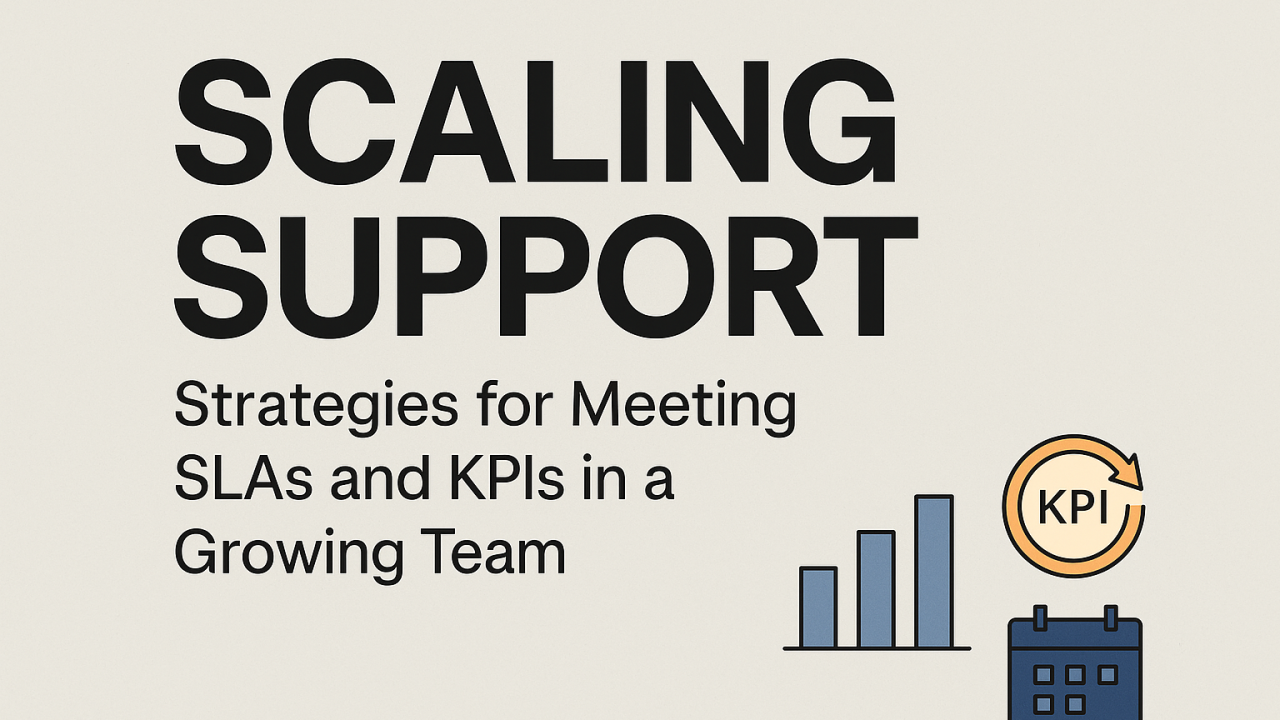Meeting SLAs and KPIs in a Growing Team

Meeting SLAs (Service Level Agreements) and KPIs (Key Performance Indicators) isn’t just a reporting obligation—it’s essential for customer satisfaction, internal alignment, and business growth.
As your support team grows, so does the complexity of maintaining high performance.
But as teams scale, what used to be manageable becomes messy. That’s where support operations must evolve—from ad hoc processes to systematic, data-driven structures.
Here are five practical strategies to help Support Leaders scale without slipping.
1. Build Process Before Headcount
Why it matters:
Before adding new team members, make sure you’re not scaling chaos. A clear, repeatable, and efficient support process ensures that every new hire amplifies your impact—not your inefficiencies.
Before increasing headcount, assess your current workflows. Are they documented? Repeatable? Scalable?
Step 1: Make Your Workflows Visible
Start by writing down the support processes your team repeats every day—think password resets, billing inquiries, Tier 1 escalations, or integration issues. Are these steps consistent across the team? If the answer is no, it’s time to create a living support playbook.
Step 2: Automate the Obvious
Every minute your agents spend tagging, assigning, or copy-pasting replies is a minute they’re not solving problems. Automate the tasks that happen 10+ times a day.
Step 3: Standardize Your Language
If five agents answer the same question five different ways, you’re not building trust—you’re creating inconsistency. Instead, build a library of macros for your most common responses.
2. Define KPIs Before Measuring People
As your team grows, misaligned metrics can create confusion, burnout, or worse—misplaced incentives. KPIs should support your strategy, not just fill a dashboard.
What gets measured gets managed—but only if it’s meaningful.
Step 1: Align Metrics With Goals
Start by clarifying what success actually looks like for your team. Are you optimizing for speed, customer satisfaction, resolution quality, or all three?
Your metrics should reflect your business priorities, not industry norms.
Make sure leadership, support managers, and frontline agents agree on what "good performance" means. Without alignment, even accurate metrics can send mixed signals.
Step 2: Choose Metrics You Can Trust
Avoid vanity metrics. Instead (they look good on paper but doesn't tell you much about value or performance, e.g. Number of tickets solved), pick KPIs that are easy to explain, actionable, and consistent over time.
Focus on metrics that lead to insights and improvements, not just good optics.
Choose metrics that are measured the same way across the team. Define each one clearly, including what tools or filters are used to generate them. Everyone should understand not just what’s being measured, but how and why.
Step 3: Make KPIs Visible and Useful
Data shouldn’t live in a spreadsheet only managers see. Surface KPIs in the tools your team already uses—your helpdesk, Slack, or a shared dashboard.
Make it easy for agents to self-check their progress and course correct in real time. When metrics are visible and tied to coaching (not just performance reviews), they become part of the culture, not just a report.
3. Structure the Team for Growth, Not Just Today
The way your team is structured today might not work tomorrow. As ticket volume increases and customer expectations evolve, so should your team’s operating model. Don’t wait for things to break—build for the next stage now.
Don’t just scale your headcount—scale your structure. A clear, flexible org model supports growth, reduces friction, and gives your team room to thrive.
Step 1: Define Clear Roles and Responsibilities
Start by ensuring every team member knows what they own—and what they don’t. Define roles not just by title, but by scope: who handles what types of tickets, who escalates, who mentors, who manages backlog.
Clarity reduces duplication and confusion, especially in a growing team where tribal knowledge no longer scales.
Step 2: Implement Tiering (or Specialization) Thoughtfully
As your team expands, a flat support model becomes inefficient. Introducing tiers or specialty pods can help handle complexity—but only if it’s done intentionally.
Tiering should be based on skill, not just experience. Specialization should align with customer needs and ticket types, not internal silos. The goal is faster, better support—not a rigid hierarchy.
Step 3: Remove Career Roadblocks
Support isn't a stepping stone—it’s a career path. But too often, talented team members feel stuck because they can’t see where they’re headed. That leads to disengagement and churn.
Create transparent, achievable growth paths. Show what’s required to move from frontline to senior roles, QA, enablement, or ops. Make advancement about skill-building, not just tenure or headcount availability.
“Most support folks don’t leave because of tickets—they leave because they don’t see a future.”
Career growth should feel like a process, not a promotion lottery. When people see a future on your team, they’ll invest in the present.
4. Build Visibility Without Micromanaging
As your team grows, you can’t rely on gut feelings or hallway chats to understand what’s going on. But visibility doesn't mean hovering—it means designing systems that surface the right signals at the right time.
You don’t need to watch every move to stay informed. Build systems that let the work speak for itself, so your team can focus on solving problems—not reporting status.
Leaders need visibility. Agents need autonomy.
Step 1: Make Work Observable
If a ticket is stuck, who knows? If an agent is overwhelmed, how do you find out? Build systems that make status, blockers, and volume visible—without needing constant check-ins.
Use dashboards, queues, or light-weight tags to show what's in progress, what’s urgent, and what needs attention. The goal isn’t surveillance—it’s shared awareness.
Step 2: Use Metrics to Guide, Not Police
Metrics should help you coach and support—not catch people doing something wrong. Instead of obsessing over averages, look for trends: Is someone’s backlog creeping up? Has resolution time jumped suddenly?
Use tools like Zendesk Explore, Dixa Insights, or even Google Sheets to track performance, but pair the data with context. Numbers are a starting point for conversations, not conclusions.
Step 3: Share the Right Info, in the Right Place
Don’t hide dashboards in tools only managers access. Bring visibility to where your team already lives—Slack, standups, or weekly summaries. Highlight wins, flag issues early, and keep everyone aligned.
When visibility is mutual, not top-down, trust grows. And so does performance.
5. Keep SLAs Realistic and Evolving
SLAs (Service Level Agreements) are meant to set expectations, not to create pressure cookers. As your team grows, your SLAs should evolve—based on your capacity, customer needs, and the actual complexity of your product.
SLAs work best when they’re grounded in reality and built to adapt. Set them to serve your customers and your team—not to chase numbers that no longer make sense.
Step 1: Align SLAs With Reality
Don’t copy industry benchmarks blindly. Instead, analyze your team’s performance and workload to define SLAs that are ambitious, but achievable. If you consistently miss an SLA, it’s not a motivation issue—it’s a signal the goal might be wrong.
Work with Product, Success, and Sales to make sure customer promises match what Support can realistically deliver.
Step 2: Use SLAs to Prioritize, Not Punish
SLAs should help you triage, not just tally. Use them to route urgent issues, surface high-risk accounts, and flag delays early. Avoid turning SLAs into a scoreboard—especially if they ignore ticket complexity or effort.
Balance speed with quality. A fast reply that solves nothing doesn’t help the customer—or the team.
Step 3: Review and Adjust as You Grow
SLAs shouldn’t be set in stone. Revisit them every year or so (or at major product or staffing changes). Use actual ticket data and customer feedback to tweak thresholds, adjust priority definitions, or change response windows.
Support isn’t static. Your SLAs shouldn’t be either.
Final Thoughts
Scaling a support team isn't just about adding more people. It’s about building smarter systems, intentional processes, and a culture that grows with your team—not ahead or behind it.
When you focus on structure, visibility, realistic goals, and sustainable workflows, hitting SLAs and KPIs becomes a natural outcome—not a constant firefight.
Support leaders have an opportunity to shape how their teams scale—not just faster, but better.
Let’s keep the conversation going
What’s worked for you when scaling support operations? What mistakes have helped you learn the most?
Drop a comment or message me—I'd love to hear how you're approaching growth on your team.

